You should dilute your fragrance oils to protect your skin from chemical burns and irritation while ensuring ideal scent performance. Proper dilution with carrier oils like jojoba or coconut creates balanced, long-lasting fragrances and prevents oxidation. By following recommended ratios (1-3% for essential oils, 10-20% for synthetic oils), you'll achieve safer, more effective results. Understanding the science of dilution will help you create professional-quality scent experiences.
Understanding the Science Behind Fragrance Oil Dilution
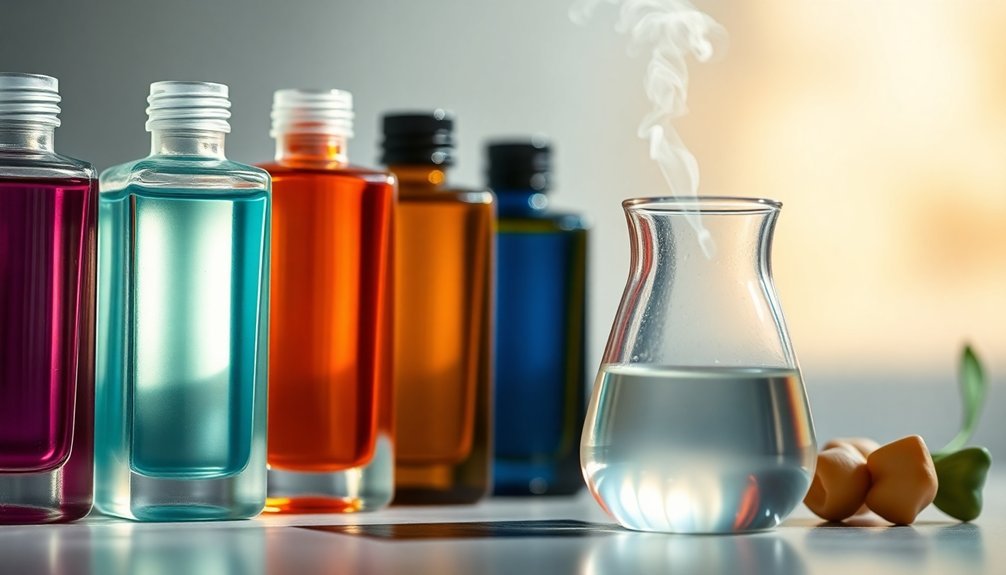
While fragrance oils can smell delightful straight from the bottle, understanding their dilution is fundamental for achieving the perfect scent intensity.
When you dilute fragrance oils, you're not just making them last longer – you're creating a more balanced and enjoyable scent experience.
Different types of fragrances require specific dilution ratios. Essential oils work best at 1-3% dilution, while synthetic fragrance oils can handle 10-20%.
Your choice of dilution agent matters too: carrier oils like jojoba work well for skin products, alcohol enhances room sprays, and water suits diffusers.
Through proper dilution, you'll prevent oxidation, maintain stability, and guarantee your fragrances don't become overwhelming. Using undiluted oils directly on skin can cause severe chemical burns and irritation.
Plus, you'll get more value from your oils while creating perfectly balanced scents that last longer.
Essential Safety Measures for Skin Application
Safety takes center stage when applying fragrance oils to your skin, building on the principles of proper dilution.
You'll need to conduct a patch test before using any new fragrance oil by applying a small amount of the diluted product to your inner wrist or elbow and waiting 24 hours for potential reactions.
Never apply undiluted fragrance oils directly to your skin, as they can cause irritation, sensitization, or phototoxic reactions.
Using carrier oils like coconut provides a nourishing base for safe dilution and application. Instead, mix them with carrier oils like jojoba or sweet almond oil at a 1% dilution ratio to start. If you're using citrus-based fragrances, apply them only at night to prevent sun sensitivity.
Keep the oils away from sensitive areas, including your eyes and mucous membranes.
If you experience any adverse reactions, stop use immediately and seek medical advice.
Optimal Dilution Ratios for Different Uses
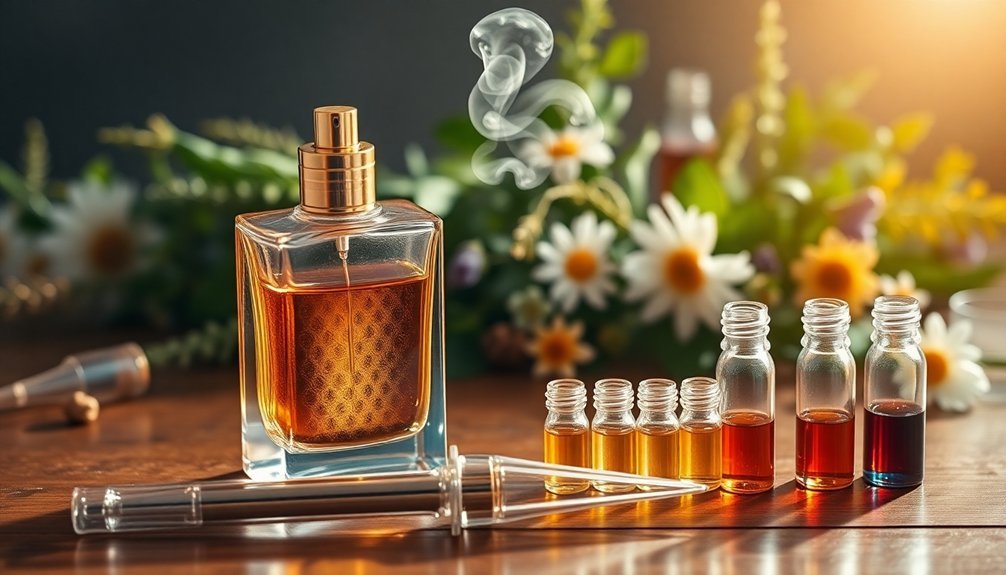
Understanding proper dilution ratios forms the cornerstone of safe and effective fragrance oil use.
When you're creating facial products, stick to a 1% dilution, using 5-6 drops per ounce of carrier oil. This gentle ratio is ideal for sensitive skin and vulnerable groups. A qualified toxicologist on staff oversees safety guidelines for dilution recommendations.
For general skincare and massage oils, you'll want a 2% dilution with 10-12 drops per ounce. This works well for daily body care products.
If you're targeting specific health concerns, a 3% dilution using 15-18 drops per ounce provides stronger therapeutic benefits.
For perfumes, you can go up to 5% dilution, using 25-30 drops per ounce. However, you shouldn't apply these stronger concentrations all over your body – they're meant for localized use and should be tested carefully to avoid skin irritation.
The Role of Carrier Oils in Fragrance Blending
Carrier oils serve as the essential foundation for any fragrance blend, acting as both a protective barrier and delivery system for essential oils. When you're selecting a carrier oil, you'll want to take into account its natural scent to guarantee it complements your fragrance blend.
Popular options like jojoba, sweet almond, and fractionated coconut oil offer neutral scents and reliable stability.
Your carrier oil choice does more than just dilute – it helps prevent the rapid evaporation of essential oils and assures they're properly absorbed into your skin. Without a carrier oil, you'd lose about 95% of your fragrance through evaporation.
These oils also protect your blend from oxidation and degradation, extending its shelf life while providing additional skincare benefits like hydration and nourishment. Each carrier oil brings unique properties to your blend.
Maximizing Fragrance Longevity Through Proper Dilution
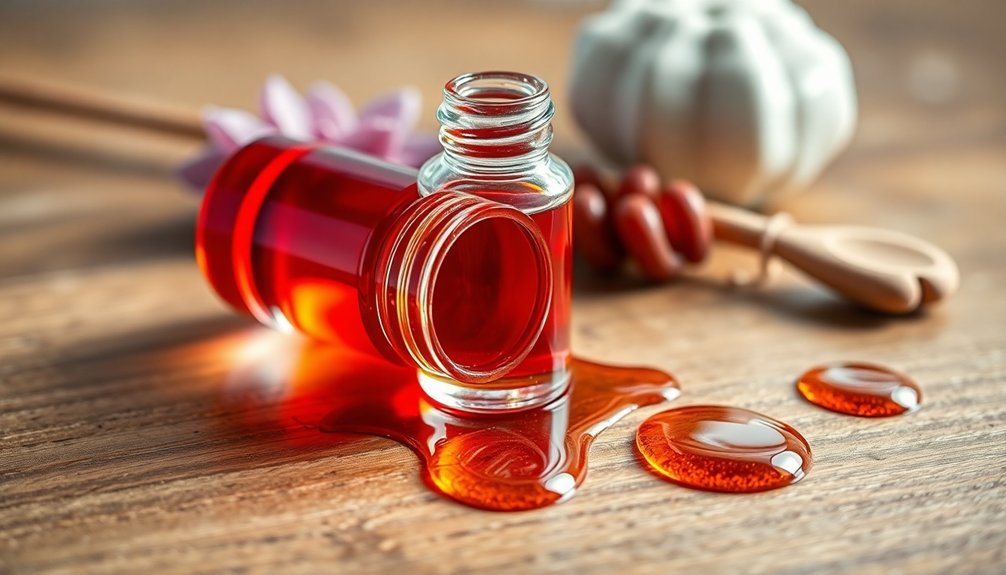
Proper dilution stands at the heart of creating long-lasting fragrances that maintain their intended scent profile. You'll find that higher oil concentrations, like those in Eau de Parfum, offer superior longevity compared to lighter formulations.
By carefully diluting your fragrance oils, you're not just extending wear time – you're optimizing the entire scent development.
To maximize your fragrance's staying power, you'll want to focus on proper layering techniques and include base notes like sandalwood, amber, or vanilla.
Store your diluted blends in cool, dark places to prevent degradation. Remember to apply your fragrance to moisturized skin and pulse points, but don't rub your wrists together.
This careful attention to dilution and application guarantees you'll enjoy your favorite scent longer while maintaining its intended character.
Cost-Effective Benefits of Diluting Fragrances
Beyond fragrance longevity, the financial advantages of diluting fragrance oils make it an attractive practice for both DIY enthusiasts and commercial producers.
You'll greatly reduce your costs since dilution allows you to use less raw material while achieving the desired scent intensity. When you pre-dilute your fragrances, you can experiment with smaller trial batches, cutting down on product development expenses.
The cost-effectiveness extends beyond immediate savings. You'll find that your fragrance oils last longer, reducing how often you need to purchase new supplies.
For DIY perfumers who typically buy in smaller quantities, proper dilution guarantees you're making the most of your materials. This practice helps you avoid wasting expensive oils through excessive application while maintaining consistent quality in your final products.
Step-by-Step Guide to Perfect Dilution Calculations

You'll find mastering dilution calculations straightforward once you understand the basic ratio of drops to carrier oil volume (12 drops per ounce for a 2% dilution).
Start by testing small batches using simple measurements, like creating a 2-teaspoon test mixture, to minimize waste and confirm your preferred fragrance strength.
Once you're confident with your calculations and results, you can scale up to larger quantities while maintaining the same proportions.
Basic Ratio Formulas
Understanding basic ratio formulas for fragrance dilution starts with three essential calculations every perfumer must master. You'll need to determine your total weight, calculate your concentrate amount, and figure out your solvent requirements.
| Formula Type | Calculation Method | Example |
|---|---|---|
| Total Weight | Final mixture weight | 120g desired product |
| Concentrate | Weight x percentage | 120g x 0.2 = 24g |
| Solvent | Total – concentrate | 120g – 24g = 96g |
For precise measurements, you'll want to use a scale rather than counting drops. When working with highly potent materials, consider using serial dilutions to achieve your target concentration. Start with a 10% solution, then dilute further to 1% or 0.1% as needed. This method helps you maintain accuracy while preserving your valuable raw materials.
Testing Small Batches First
While mastering ratio formulas sets the foundation, testing small batches represents the smart path to perfecting your fragrance dilutions. You'll save money by using minimal materials while identifying potential issues early.
Using precise measurements with a scale, rather than counting drops, guarantees you can replicate successful formulations consistently.
Testing small batches also reveals how your fragrance performs in different mediums, from wax to soap bases. You'll understand the scent throw, longevity, and interaction with other ingredients before scaling up production.
This approach lets you evaluate the fragrance's strength and character over time while guaranteeing skin safety through patch testing.
Most importantly, you'll avoid costly mistakes and create balanced, harmonious blends that enhance the user experience without overwhelming concentrations.
Common Mistakes to Avoid When Diluting Oils
Making mistakes when diluting fragrance and essential oils can lead to serious consequences for both safety and effectiveness. You'll want to avoid using undiluted oils directly on your skin, as this can cause severe reactions and sensitization. It's essential to follow proper dilution ratios and always conduct patch tests before full application.
| Mistake | Consequence | Solution |
|---|---|---|
| No dilution | Skin reactions, rashes | Use proper carrier oil |
| Wrong ratio | Ineffective or harmful | Follow 1-3% guideline |
| Skipping patch test | Unknown allergic risks | Test small area first |
| Poor dilution agent | Product separation | Use appropriate carrier |
| Excessive dilution | Weak fragrance | Follow recommended % |
Remember to use appropriate dilution agents – carrier oils for skin products, alcohol for room sprays, and emulsifiers for water-based applications.
Storage and Shelf Life of Diluted Fragrances
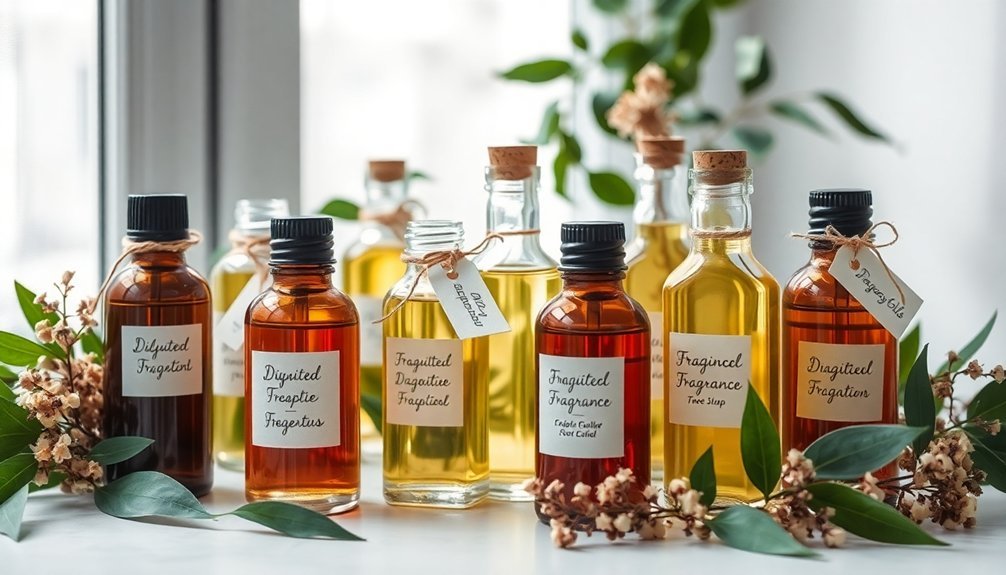
Proper storage of diluted fragrances plays an essential role in maintaining their quality and extending their shelf life. You'll want to store your diluted oils in dark glass bottles and keep them in a cool, dry place around 60 degrees Fahrenheit.
Avoid exposing them to direct sunlight or artificial light, as this can break down their chemical composition.
To prevent oxidation, minimize the headspace in your bottles by transferring diluted oils to smaller containers. Always replace caps tightly after use and avoid excessive shaking.
Keep track of when you first opened the fragrance, as most diluted oils last 1-2 years with proper storage. You can extend their shelf life by storing them in the fridge, but remember to take them out 1-2 hours before use.
Creating Custom Blends With Proper Ratios
You'll want to start your custom fragrance journey with small batches, measuring each oil precisely to maintain proper ratios of 30% top notes, 50% middle notes, and 20% base notes.
For skin-safe blends, stick to a 2% dilution rate (10-12 drops per ounce of carrier oil) to prevent irritation while ensuring effectiveness.
Track your measurements carefully as you experiment, allowing you to replicate successful blends and scale them up later.
Measuring For Perfect Balance
When creating custom fragrance blends, precise measurements and ratios form the foundation of a successful formulation.
You'll need to understand the difference between fragrance load and content to achieve consistent results. While load is calculated as a percentage of wax only, content includes both wax and oil in the total weight.
Start with the general ratio of 6% to 10% fragrance oil to wax, adjusting based on your wax type and desired scent intensity. For example, if you're using 500g of wax at 8%, you'll need 40g of fragrance oil.
When working with potent materials, consider pre-diluting them to achieve more accurate dosing. Some ingredients may require dilution to 10% or even 0.01%, depending on their strength.
Always test small batches to guarantee your blend meets expectations.
Safe Blending Starter Tips
Creating custom fragrance blends requires a systematic approach that prioritizes both safety and precision.
You'll need to protect yourself by wearing gloves and goggles while working in a well-ventilated space. Before mixing oils, verify you've checked the IFRA guidelines and safety data sheets for each fragrance.
When you're ready to blend, follow these essential ratios for balanced compositions:
- Standard blend: 30% top notes, 50% middle notes, 20% base notes
- Basic blend: Equal 1:1:1 ratio of all three notes
- Complex blend: 3:2:1 or 4:2:1 ratio for more sophisticated scents
Start with small batches using precise measurements, and document your process in a fragrance journal.
Let your blends mature for several days before making final adjustments, as the scent will evolve and settle.
Professional Tips for Achieving Balanced Scents
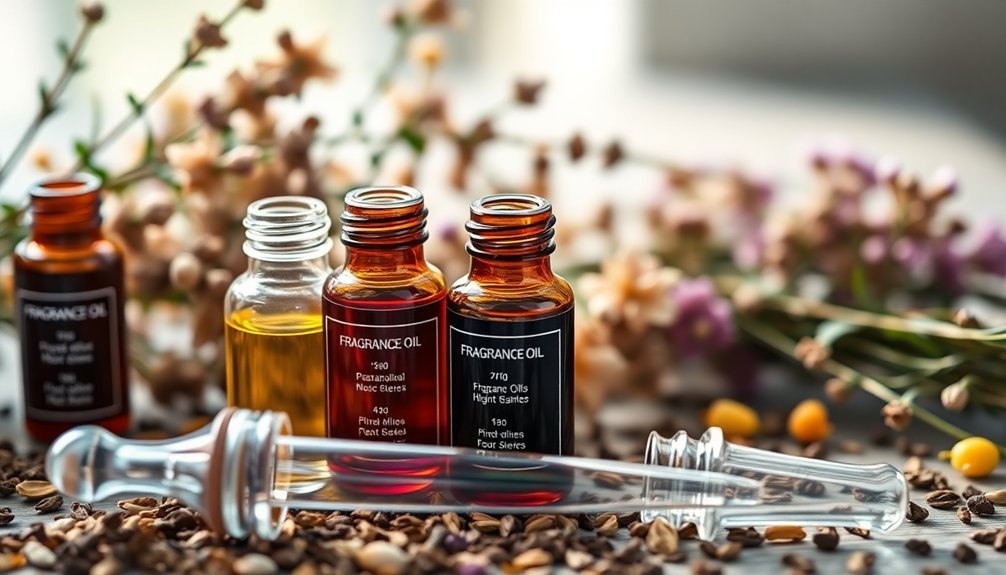
Professional perfumers rely on specific techniques and proven methods to achieve perfectly balanced fragrances. You'll want to start by testing small batches of your diluted oils, which allows you to perfect your ratios before committing to larger quantities.
Always use precise measurements to balance your top, middle, and base notes effectively.
When you're working with complex blends, you'll find it easier to evaluate certain materials in their diluted form. This practice helps you detect subtle nuances and create fuller scent profiles.
Consider using perfumer's alcohol for dilution, as it's an excellent tool for training your nose and appraising odor profiles. Pre-diluting your materials isn't just about safety – it's also cost-effective, especially when you're working with expensive or highly concentrated oils.
Measuring and Testing Diluted Fragrances
You'll need accurate measuring tools like digital scales, pipettes, or measuring spoons to properly dilute your fragrance oils and track your results.
Before applying any diluted fragrance to your skin, conduct a patch test on a small area to check for adverse reactions and sensitivities.
Keep detailed records of your dilution ratios, dates, and testing outcomes to maintain consistency and safety in future batches.
Proper Equipment and Tools
When diluting fragrance oils with precision, having the right equipment and tools is essential for accurate measurements and quality control.
You'll need protective gear like gloves and safety glasses to handle materials safely, while specialized measuring tools guarantee consistency in your dilutions.
For professional-grade dilutions, you should have these core items:
- Digital scales that measure to the hundredths (0.00) and borosilicate beakers for precise measurements
- Stainless steel equipment including funnels, strainers, and measuring cups for safe material handling
- Testing tools such as a conductivity meter and lab-quality filter paper to verify dilution quality
Don't forget essential analytical equipment like thermometers for monitoring temperatures and pipettes for transferring liquids accurately.
These tools will help you achieve consistent, high-quality results in your fragrance dilutions.
Test Patch Safety Guidelines
Having the right tools sets the foundation for diluting fragrance oils, but safety testing remains equally important for preventing adverse skin reactions.
You'll need to conduct a patch test by applying one drop of your diluted fragrance to the inside of your wrist or elbow, then waiting 24 hours to check for any irritation.
Start with a conservative 1-2% dilution ratio in your chosen carrier oil, such as jojoba or fractionated coconut oil.
If you're working with synthetic fragrances, you can increase this up to 10-20%, while essential oils should stay between 1-3%.
Watch for signs of redness, itching, or inflammation during your patch test.
If you experience any adverse reactions, discontinue use immediately and consider consulting a healthcare provider for severe reactions.
Record Dilution Results
Three essential steps make up the process of recording dilution results: measuring, testing, and documenting.
You'll need to carefully track your dilution ratios and maintain detailed records of your fragrance experiments.
When recording your results, follow these key steps:
- Document your dilution calculations, including the exact number of drops used per fluid ounce and the percentage of dilution achieved.
- Record the chromatographic profiles and retention times if you're using GC-FID analysis for quality control.
- Write detailed notes about your organoleptic testing, including how the fragrance develops over time and any changes in the scent profile.
Remember to label all your samples clearly and keep track of the solvents used.
You'll find this documentation invaluable when you need to reproduce successful formulations or troubleshoot issues in your dilutions.
Frequently Asked Questions
Can I Use Water Instead of Carrier Oils to Dilute Fragrance Oils?
You can't effectively use water alone to dilute fragrance oils since they won't mix properly. You'll need an emulsifier if you want to use water, but carrier oils work much better for dilution.
Will Diluting Fragrances Change Their Original Scent Profile Over Time?
Yes, your fragrance's scent profile can change over time when diluted. The interaction with dilution agents, exposure to light, and storage conditions will affect how the scent evolves during its shelf life.
How Often Should I Remake Diluted Fragrance Oil Blends?
You'll need to remake diluted fragrance blends every 6-12 months, depending on your storage conditions and ingredients. Check for changes in scent profile, and remake sooner if you notice significant degradation.
Can I Mix Different Carrier Oils When Diluting a Single Fragrance?
Yes, you can mix different carrier oils when diluting a fragrance. It's great for customizing properties and benefits for your skin. Just verify the oils are compatible and maintain proper dilution ratios for safety.
Does Temperature Affect the Dilution Process of Fragrance Oils?
No, temperature doesn't affect the dilution process of your fragrance oils. While it's important for candle making and wax mixing, you can safely dilute your oils at room temperature with carrier oils.
In Summary
By diluting your fragrance oils properly, you'll protect your skin, extend your product's life, and create perfectly balanced scents. Whether you're making perfumes, room sprays, or aromatherapy blends, remember that proper dilution is key to success. Start with recommended ratios, test your mixtures, and don't be afraid to adjust until you achieve your desired results. Your careful attention to dilution will reward you with safe, effective, and long-lasting fragrances.

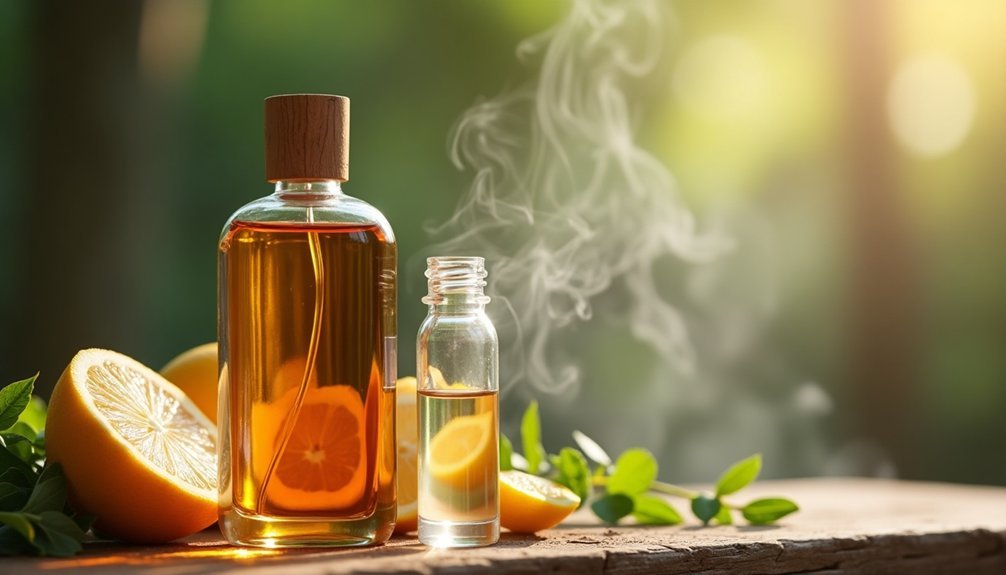



Leave a Reply